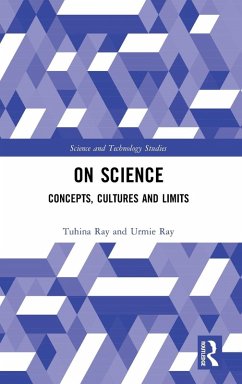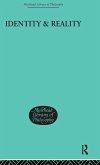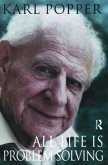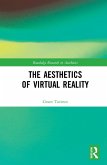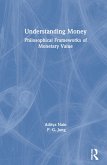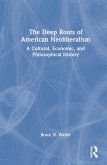- Gebundenes Buch
- Merkliste
- Auf die Merkliste
- Bewerten Bewerten
- Teilen
- Produkt teilen
- Produkterinnerung
- Produkterinnerung
On Science: Concepts, Cultures, and Limits explores science and its relationship with religion, philosophy, ethics, mathematics, and with socio-economic changes. It gives an overview of the metaphysical contexts in which science emerged and the particular forms science has taken in history.
Andere Kunden interessierten sich auch für
![Masses, Classes, Ideas Masses, Classes, Ideas]() Etienne BalibarMasses, Classes, Ideas173,99 €
Etienne BalibarMasses, Classes, Ideas173,99 €![Identity & Reality Identity & Reality]() Emile MeyersonIdentity & Reality231,99 €
Emile MeyersonIdentity & Reality231,99 €![All Life is Problem Solving All Life is Problem Solving]() Karl PopperAll Life is Problem Solving185,99 €
Karl PopperAll Life is Problem Solving185,99 €![The Aesthetics of Virtual Reality The Aesthetics of Virtual Reality]() Grant TavinorThe Aesthetics of Virtual Reality167,99 €
Grant TavinorThe Aesthetics of Virtual Reality167,99 €![Understanding Money Understanding Money]() Aditya NainUnderstanding Money167,99 €
Aditya NainUnderstanding Money167,99 €![The Deep Roots of American Neoliberalism The Deep Roots of American Neoliberalism]() Bruce N. WallerThe Deep Roots of American Neoliberalism167,99 €
Bruce N. WallerThe Deep Roots of American Neoliberalism167,99 €![The Path to Mass Evil The Path to Mass Evil]() Michael HardimanThe Path to Mass Evil167,99 €
Michael HardimanThe Path to Mass Evil167,99 €-
-
-
On Science: Concepts, Cultures, and Limits explores science and its relationship with religion, philosophy, ethics, mathematics, and with socio-economic changes. It gives an overview of the metaphysical contexts in which science emerged and the particular forms science has taken in history.
Produktdetails
- Produktdetails
- Verlag: Routledge India
- Seitenzahl: 266
- Erscheinungstermin: 21. Dezember 2020
- Englisch
- Abmessung: 240mm x 161mm x 19mm
- Gewicht: 567g
- ISBN-13: 9780367442552
- ISBN-10: 0367442558
- Artikelnr.: 60013341
- Herstellerkennzeichnung
- Libri GmbH
- Europaallee 1
- 36244 Bad Hersfeld
- gpsr@libri.de
- Verlag: Routledge India
- Seitenzahl: 266
- Erscheinungstermin: 21. Dezember 2020
- Englisch
- Abmessung: 240mm x 161mm x 19mm
- Gewicht: 567g
- ISBN-13: 9780367442552
- ISBN-10: 0367442558
- Artikelnr.: 60013341
- Herstellerkennzeichnung
- Libri GmbH
- Europaallee 1
- 36244 Bad Hersfeld
- gpsr@libri.de
Tuhina Ray (formerly Ghose) read physics at Presidency College, she was the recipient of the Bhabatarini Medal and Bhranti Basu Medal in 1947, and of the Roxburgh Gold Medal in 1949, the best university student at the postgraduate level award in science in 1953, she obtained a D.Phil. from the University of Calcutta in 1956, and was appointed as a Reader at the Saha Institute of Fundamental Research. Forced by political circumstances, she and her family left India in 1967 and she held research positions in academic institutions of France and Germany. A keen sportswoman in her student days, her broad interests and erudition took her to diverse horizons. She passed away in 2018. Urmie Ray read mathematics at the University of Cambridge, U.K., completing her Ph.d. under the guidance of Professor J. G. Thompson. After 20 years as an academic mathematician, she resigned her professorship in France to dedicate herself to her lifelong interests in cultural and historical questions in order to better understand current issues.
Acknowledgements. Prologue. Part I: On Science 1. What is Science? 2.
Science in the Service of All-Comprehensive Truth 3. Science in the Service
of External Truth 4. On Mathematics 5. Knowledge of Materials Part II: Some
Glimpses of Science in Action 6. The Physics of Motion 7. From Atoms to
Geological Questions 8. The Life Sciences 9. Evolving Perceptions Part III:
from Science to Dogma 10. The Shortcomings of Science 11. Science in
Context 12. In the Name of Science 13. Scientism: A New Creed 14. Science
and Our Future Epilogue. Bibliography. Index.
Science in the Service of All-Comprehensive Truth 3. Science in the Service
of External Truth 4. On Mathematics 5. Knowledge of Materials Part II: Some
Glimpses of Science in Action 6. The Physics of Motion 7. From Atoms to
Geological Questions 8. The Life Sciences 9. Evolving Perceptions Part III:
from Science to Dogma 10. The Shortcomings of Science 11. Science in
Context 12. In the Name of Science 13. Scientism: A New Creed 14. Science
and Our Future Epilogue. Bibliography. Index.
Acknowledgements. Prologue. Part I: On Science 1. What is Science? 2. Science in the Service of All-Comprehensive Truth 3. Science in the Service of External Truth 4. On Mathematics 5. Knowledge of Materials Part II: Some Glimpses of Science in Action 6. The Physics of Motion 7. From Atoms to Geological Questions 8. The Life Sciences 9. Evolving Perceptions Part III: from Science to Dogma 10. The Shortcomings of Science 11. Science in Context 12. In the Name of Science 13. Scientism: A New Creed 14. Science and Our Future Epilogue. Bibliography. Index.
Acknowledgements. Prologue. Part I: On Science 1. What is Science? 2.
Science in the Service of All-Comprehensive Truth 3. Science in the Service
of External Truth 4. On Mathematics 5. Knowledge of Materials Part II: Some
Glimpses of Science in Action 6. The Physics of Motion 7. From Atoms to
Geological Questions 8. The Life Sciences 9. Evolving Perceptions Part III:
from Science to Dogma 10. The Shortcomings of Science 11. Science in
Context 12. In the Name of Science 13. Scientism: A New Creed 14. Science
and Our Future Epilogue. Bibliography. Index.
Science in the Service of All-Comprehensive Truth 3. Science in the Service
of External Truth 4. On Mathematics 5. Knowledge of Materials Part II: Some
Glimpses of Science in Action 6. The Physics of Motion 7. From Atoms to
Geological Questions 8. The Life Sciences 9. Evolving Perceptions Part III:
from Science to Dogma 10. The Shortcomings of Science 11. Science in
Context 12. In the Name of Science 13. Scientism: A New Creed 14. Science
and Our Future Epilogue. Bibliography. Index.
Acknowledgements. Prologue. Part I: On Science 1. What is Science? 2. Science in the Service of All-Comprehensive Truth 3. Science in the Service of External Truth 4. On Mathematics 5. Knowledge of Materials Part II: Some Glimpses of Science in Action 6. The Physics of Motion 7. From Atoms to Geological Questions 8. The Life Sciences 9. Evolving Perceptions Part III: from Science to Dogma 10. The Shortcomings of Science 11. Science in Context 12. In the Name of Science 13. Scientism: A New Creed 14. Science and Our Future Epilogue. Bibliography. Index.

